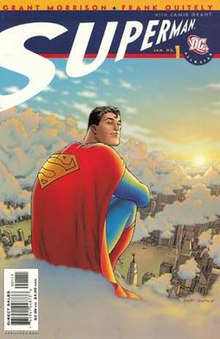The Daily Planet is a fictional newspaper appearing in American comic books published by DC Comics, commonly in association with Superman. The newspaper was first mentioned in Action Comics #9 - Underworld Politics, War on Crime. The Daily Planet building's distinguishing feature is the enormous globe that sits on top of the building.
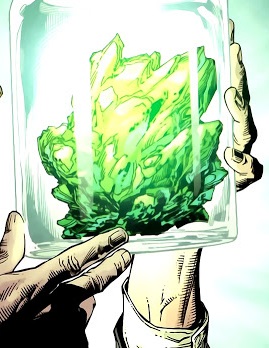
Kryptonite is a fictional material that appears primarily in Superman stories published by DC Comics. In its best-known form, it is a green, crystalline material originating from Superman's home world of Krypton that emits a unique, poisonous radiation that can weaken and even kill Kryptonians. Kryptonite radiation can be transmitted through any element except lead. Thus, Superman has a special lead suit to protect himself from the radiation. There are other varieties of kryptonite, such as red and gold kryptonite, which have different but still generally negative effects.
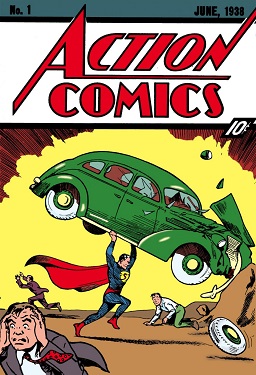
Action Comics is an American comic book/magazine series that introduced Superman, one of the first major superhero characters. The publisher was originally known as National Allied Publications, and later as National Comics Publications and as National Periodical Publications, before taking on its current name of DC Comics. Its original incarnation ran from 1938 to 2011 and stands as one of the longest-running comic books with consecutively numbered issues. The second volume of Action Comics beginning with issue #1 ran from 2011 to 2016. Action Comics returned to its original numbering beginning with issue #957.

Superboy is the name of several fictional superheroes appearing in American comic books published by DC Comics. These characters have been featured in several eponymous comic series, in addition to Adventure Comics and other series featuring teenage superhero groups.

The Question is a name used by several fictional characters appearing in American comic books published by DC Comics. Created by Steve Ditko, the Question first appeared in Charlton Comics' Blue Beetle #1, and was acquired by DC Comics in the early 1980s and incorporated into the DC Universe.

Superman: Red Son is a three-issue prestige format comic book mini-series published by DC Comics that was released under their Elseworlds imprint in 2003. Author Mark Millar created the comic with the premise "What if Superman had been raised in the Soviet Union?" It received critical acclaim and was nominated for the 2004 Eisner Award for best limited series.

Superman for All Seasons is a 4-issue comic book limited series written by Jeph Loeb with art by Tim Sale. It was originally published by DC Comics in 1998, after their previous success, Batman: The Long Halloween. After that story's theme was holidays, this one's theme dealt with seasons. The artwork contains many influences from that of Norman Rockwell. The story also parallels the events from Superman's then-origin story John Byrne's The Man of Steel, though it can be read on its own.

Perry White is a fictional character appearing in American comic books published by DC Comics. He is the editor-in-chief of the Metropolis newspaper the Daily Planet. The character maintains very high ethical and journalistic standards and is an archetypal image of the tough, irascible, but fair-minded boss.

"Whatever Happened to the Man of Tomorrow?" is a 1986 American comic book story published by DC Comics, featuring the superhero Superman. Written by British author Alan Moore with help from long-time Superman editor Julius Schwartz, the story was published in two parts, beginning in Superman #423 and ending in Action Comics #583, both published in September 1986. The story was drawn by long-time artist Curt Swan in one of his final major contributions to the Superman titles and was inked by George Pérez in the issue of Superman and Kurt Schaffenberger in the issue of Action Comics. The story was an imaginary story which told the final tale of the Silver Age Superman and his long history, which was being rebooted following the events of Crisis on Infinite Earths, before his modern introduction in the John Byrne series, The Man of Steel.

Gail Simone is an American writer best known for her work in comics on DC's Birds of Prey, Batgirl, Dynamite Entertainment's Red Sonja, and for being the longest running female writer on Wonder Woman to date. Other notable works include Clean Room, Secret Six, Welcome to Tranquility, The All-New Atom, and Deadpool.

All Star was an imprint of ongoing American comic book titles published by DC Comics that ran from 2005 to 2008. DC Comics has published two titles under the All Star banner, featuring Superman and Batman, and announced a number of titles featuring other heroes under the imprint that were never released.

52 is a weekly American comic book limited series published by DC Comics that debuted on May 10, 2006, one week after the conclusion of the Infinite Crisis miniseries. The series was written by Geoff Johns, Grant Morrison, Greg Rucka, and Mark Waid, with layouts by Keith Giffen. 52 also led into a few limited series spin-offs.

Superman is an ongoing American comic book series featuring the DC Comics superhero Superman as its protagonist. Superman began as one of several anthology features in the National Periodical Publications comic book Action Comics #1 in June 1938. The strip proved so popular that National launched Superman into his own self-titled comic book, the first for any superhero, premiering with the cover date summer 1939. Between 1986 and 2006 it was retitled, The Adventures of Superman, while a new series used the title Superman. In May 2006, it was returned to its original title and numbering. The title was canceled with issue #714 in 2011, and was relaunched with issue #1 the following month which ended its run in 2016. A fourth series was released in June 2016 and ended in April 2018, while the fifth series was launched in July 2018 and ended in June 2021. The series was replaced by Superman: Son of Kal-El in July 2021, featuring adventures of Superman's son, Jon Kent. A sixth Superman series was released in February 2023.

Justice is a twelve-issue American comic book limited series published bimonthly by DC Comics from August 2005 through June 2007, written by Alex Ross and Jim Krueger, with art also by Ross and Doug Braithwaite. Its story involves the superhero team known as the Justice League of America confronting the supervillain team the Legion of Doom after every supervillain is motivated by a shared dream that seems to be a vision of the planet's destruction, which they intend to avoid.
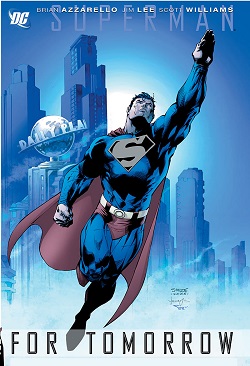
"For Tomorrow" is a 2004–2005 American comic book story arc published in Superman #204–215 by DC Comics. Written by Brian Azzarello and penciled by Jim Lee, with inks by Scott Williams, the story begins a year after a million people mysteriously vanish from the face of the earth. As the Man of Steel tries to solve the puzzle while dealing with his personal loss - as well as guilt over failing to prevent the disaster - a parallel story line concerns a priest questioning his faith and serving as Superman's confessor. This eventually gives way to a plot in which a megalomaniac bent on interplanetary conquest begins his attempt to capture his targets, and fighting through a heavy heart, Superman must stop him.
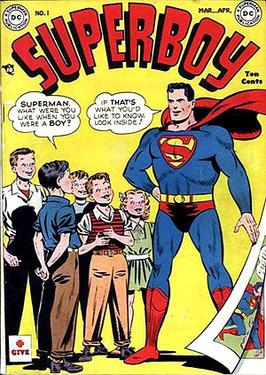
Superboy is the name of several American comic book series published by DC Comics, featuring characters of the same name. The first three Superboy titles feature the original Superboy, the underaged version of the legendary hero Superman. Later series feature the second Superboy, who is a partial clone of Superman.
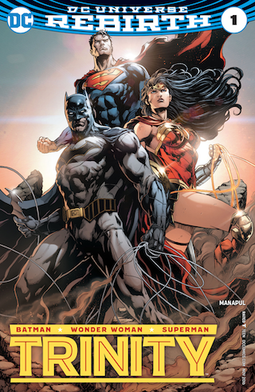
Trinity is an American comic book series published by DC Comics featuring the superheroes Superman, Batman and Wonder Woman. The first series was published weekly from 2008 to 2009. In 2016, a second monthly comic book series was launched by DC Comics.

JLA was a monthly comic book published by DC Comics from January 1997 to April 2006 featuring the Justice League of America. The series restarted DC's approach to the Justice League, which had initially featured most of the company's top-tier superheroes but shifted in the 1980s to featuring a rotating cast of established characters alongside newer ones and also saw that franchise expand to several spin-off series, diluting the prestige of the name brand. When relaunched by writer Grant Morrison, the team again focused on the most recognizable, powerful, and long-lasting heroes in DC's library.

"Batman: Battle for the Cowl" is a 2009 comic book storyline published by DC Comics, consisting of an eponymous, three-issue miniseries written and penciled by Tony Daniel, as well as a number of tie-in books. The central story details the chaos in Gotham City following the "Batman R.I.P." and "Final Crisis" story arcs, due to Batman's absence. His disappearance is caused by the character's apparent death at the hands of Darkseid in Final Crisis, which causes dissension in the ranks of his allies and enemies who fight for the right to become the new Batman.

All-Star Superman is a 2011 American animated superhero film based on the comic book series of the same name by Grant Morrison and Frank Quitely. Released direct-to-video by Warner Bros. Animation on February 22, 2011, it is the tenth film of the DC Universe Animated Original Movies.
